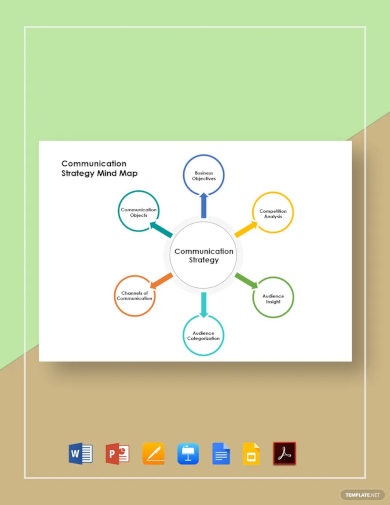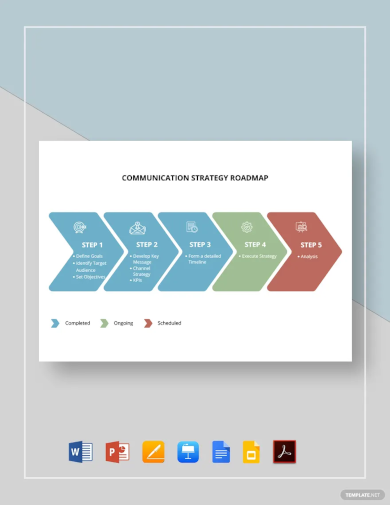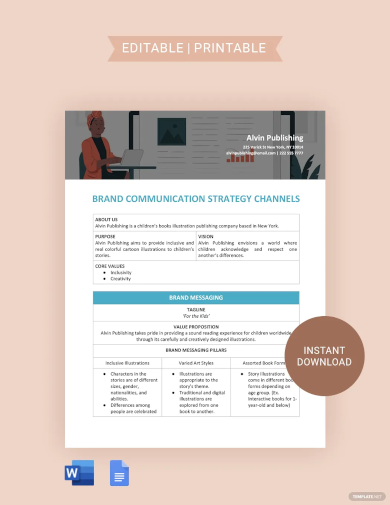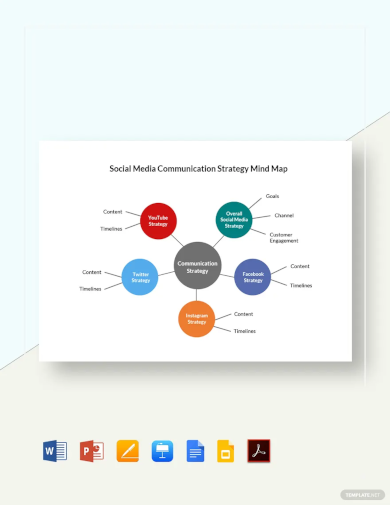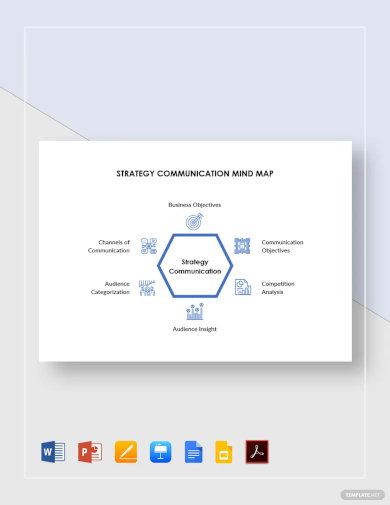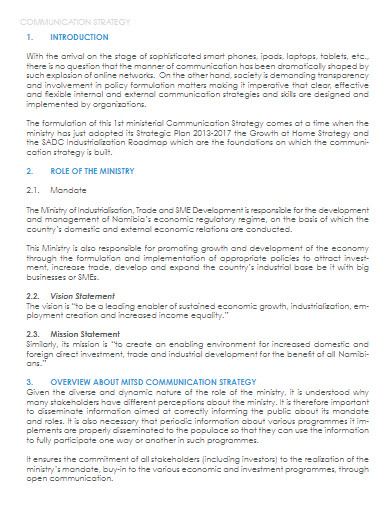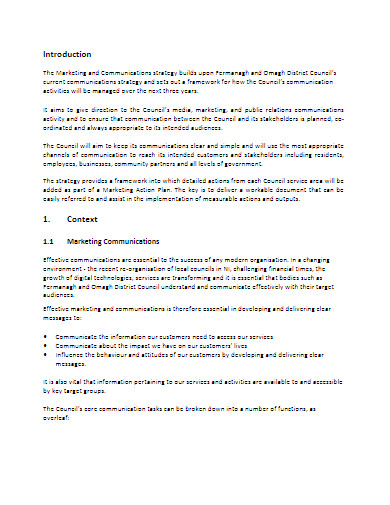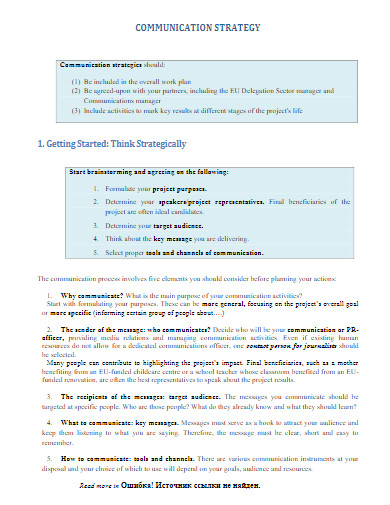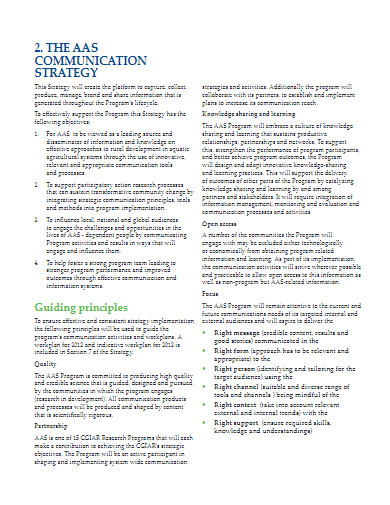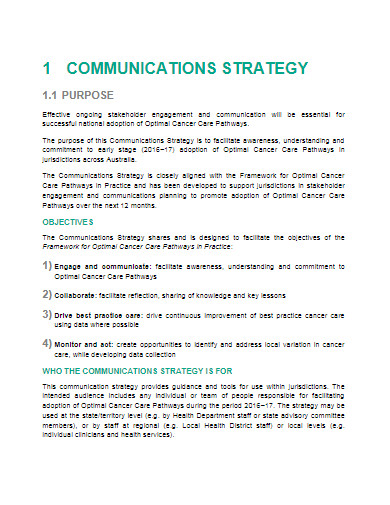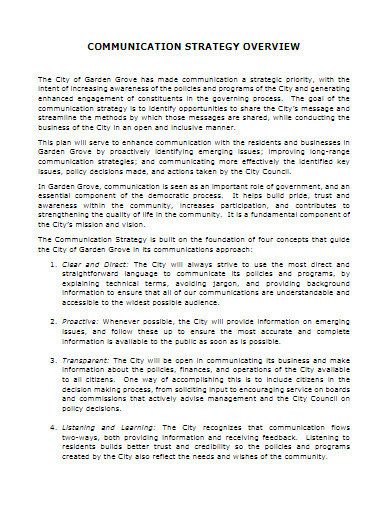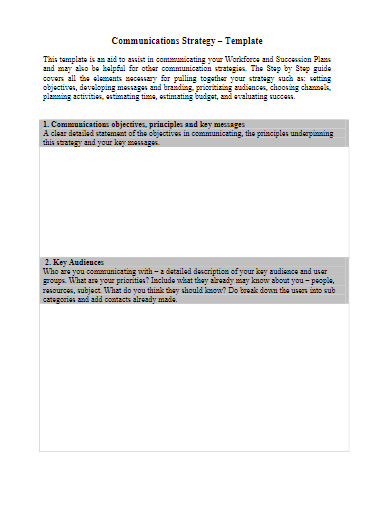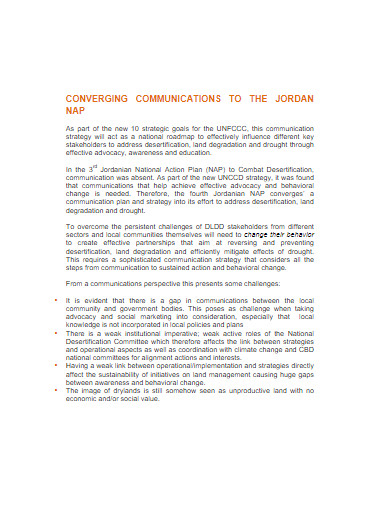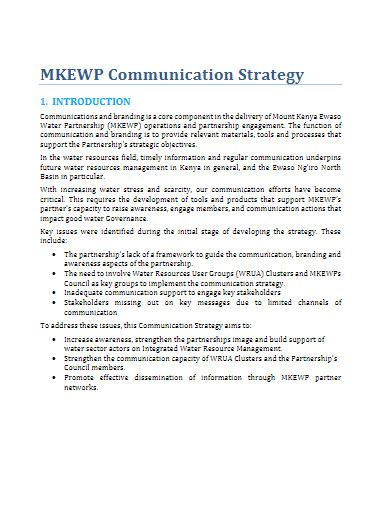99+ Communication Strategy Examples
Whether you are working for a business or a nonprofit organization, it is necessary that you can relay a message as quickly and precisely as possible. That’s why, if possible, you should have a communication strategy that allows you to improve relationships, influence movement, or create an impression. Although we now have many avenues to fulfill this and create effective communication such as social media, tv, and radio, it is still necessary to create a communication strategy. That’s why we have Communication Strategy Examples for you to use and an excellent guide to help you create one.
What is Communication Strategy? – Definition
A communication strategy is an essential roadmap for conveying information effectively. It is the deliberate plan that outlines how to spread your message to the audience, ensuring it’s received as intended. This strategy encompasses the who, what, when, where, and how of your communication efforts, aligning them with your overarching goals.
What is the Best Example of Communication Strategy?
The best communication strategy is one that delivers a message so effectively that it inspires action and drives change. One notable example is a public awareness campaign that uses a mix of engaging social media content, informative pamphlets, and community events to disseminate vital information and mobilize the community towards a common goal, like recycling or voting. This type of strategy connects with individuals on multiple levels, creating a cohesive and compelling call to action.
100 Communication Strategy Examples
Effective communication strategies are pivotal for achieving organizational goals and engaging stakeholders. This insightful collection features 100 distinct and dynamic examples, each underscoring unique approaches to delivering messages with precision and persuasion. Ranging from internal team briefings to expansive social media campaigns, these strategies demonstrate the power of tailored messaging to inform, inspire, and influence diverse audiences.
- CEO Town Hall Meetings: Regular, all-hands meetings led by the CEO to update employees on corporate goals, achievements, and future plans, fostering transparency and unity.
- Customer Feedback Surveys: Utilizing surveys to gather customer opinions, thereby shaping services/products to better meet consumer needs and enhance satisfaction.
- Email Newsletters: Weekly or monthly newsletters providing updates, content, and offers to maintain engagement and inform subscribers.
- Social Media Takeovers: Inviting influencers to ‘take over’ company social media accounts, reaching new audiences with a fresh perspective.
- Interactive Webinars: Hosting online seminars with Q&A sessions to educate and interact with the audience on relevant topics.
- Cross-Functional Team Updates: Encouraging departments to share projects and progress, promoting interdepartmental cooperation and knowledge sharing.
- Crisis Communication Plans: Preparing and implementing structured responses for potential crises to manage public perception and maintain trust.
- Brand Storytelling: Crafting and sharing the brand’s history and values through storytelling to create an emotional connection with the audience.
- Infographic Distribution: Using visually appealing infographics in online and offline media to simplify and enhance the dissemination of complex information.
- Press Release Circulation: Announcing newsworthy company developments through press releases to media outlets for wider coverage.
- Community Outreach Programs: Initiating programs that support local communities, enhancing brand image, and fostering goodwill.
- Content Marketing: Creating and distributing valuable, relevant content to attract and engage a clearly defined audience.
- Employee Advocacy: Encouraging employees to share their positive experiences and company news on their personal social channels.
- Trade Show Presentations: Engaging with industry peers and potential clients through informative and interactive trade show booths and presentations.
- Corporate Social Responsibility Reports: Sharing annual CSR efforts and achievements with stakeholders to demonstrate the company’s commitment to social and environmental causes.
- Podcasting: Releasing regular podcast episodes on topics related to the company’s industry to build a community of engaged listeners.
- User-Generated Content Campaigns: Inviting customers to create content for the brand, increasing engagement, and trust.
- Referral Programs: Implementing systems where current customers can refer friends or colleagues, leveraging word-of-mouth.
- Educational Blog Series: Offering a series of informative blog posts on industry-related subjects to establish authority and provide value.
- Live Tweeting Events: Providing real-time updates and engagement during events, keeping the online community involved.
- Hashtag Campaigns: Creating unique hashtags for campaigns to track conversations and engagement across social media platforms.
- Peer-to-Peer Communication Networks: Establishing internal platforms for employees to share ideas and feedback directly with each other.
- Annual Reports: Presenting yearly performance and future outlooks to inform and assure investors and stakeholders.
- Video Testimonials: Sharing customer experiences through video to provide social proof and build credibility.
- Internal Newsletters: Keeping staff updated on internal news and events with regular newsletters, promoting a cohesive company culture.
- Virtual Reality Experiences: Offering immersive VR experiences at events or in-store to showcase products/services in a memorable way.
- Chatbots for Customer Service: Implementing AI-powered chatbots on websites for instant customer service and engagement.
- Loyalty Programs: Creating programs that reward repeat customers, strengthening relationships, and encouraging ongoing business.
- Influencer Partnerships: Collaborating with influencers to promote products/services to a wider, targeted audience.
- Direct Mail Campaigns: Sending personalized mail to customers’ homes to stand out in the digital age and create a tangible connection.
- Leadership Articles: Publishing thought leadership pieces by company executives on professional networks like LinkedIn to build industry credibility.
- Employee Onboarding Processes: Ensuring a smooth introduction for new hires with a clear, informative communication process.
- Client Success Stories: Showcasing how customers have successfully used a product or service to solve a problem or achieve a goal.
- Mobile App Notifications: Sending timely and relevant push notifications to app users to keep them engaged and informed.
- Bilingual Communications: Providing content in multiple languages to cater to a diverse audience and expand market reach.
- Reputation Management Strategies: Monitoring and influencing the online reputation of a brand through proactive communication and feedback loops.
- Digital Signage: Utilizing digital displays in high-traffic areas to broadcast dynamic content and capture attention.
- Personalized Video Messages: Sending bespoke video messages to clients or employees for special occasions, adding a personal touch.
- FAQ Sections on Websites: Maintaining comprehensive FAQ sections to preemptively answer common customer questions.
- Online Community Forums: Building platforms where customers can discuss products and services, fostering a sense of community and loyalty.
- Sustainability Initiatives: Communicating a brand’s sustainability initiatives to showcase commitment to environmental stewardship.
- Employee Profile Features: Highlighting individual employees and their stories on social media to humanize the brand and showcase company culture.
- Post-Purchase Follow-Up Emails: Engaging customers with follow-up emails after a purchase to thank them and encourage feedback.
- Multimedia Press Kits: Offering media outlets a variety of multimedia resources to facilitate varied and dynamic coverage of news and events.
- Stakeholder Meetings: Hosting regular meetings with key stakeholders to share insights, gather feedback, and align on objectives.
- Customer Case Studies: Detailed accounts of how a company has made a positive impact on a customer’s business or life.
- Anniversary Celebrations: Marking company milestones with events or campaigns that reflect on past achievements and set future goals.
- Seasonal Marketing Campaigns: Tailoring communication strategies to seasonal events and holidays to remain relevant and engaging.
- Behind-the-Scenes Content: Sharing the making-of or behind-the-scenes glimpses into the company’s processes or culture.
- Mentorship Programs: Encouraging knowledge sharing and relationship building through structured mentorship within the company.
- Joint Venture Announcements: Communicating new partnerships or joint ventures that expand the company’s capabilities and offerings.
- Guerrilla Marketing Tactics: Creating unexpected, unconventional, and low-cost marketing tactics that yield maximum impact.
- Co-Branding Initiatives: Partnering with other brands to combine strengths, expand reach, and tap into new customer bases.
- Product Unboxing Videos: Leveraging the popularity of unboxing videos to generate excitement and visibility for new products.
- Customer Onboarding Sequences: Guiding new customers through the initial stages of using a product/service for a smooth experience.
- Thought Leadership Panels: Organizing or participating in panels to discuss industry trends and position the company as a thought leader.
- Employee Performance Reviews: Conducting regular, constructive communication sessions to discuss employee performance and development.
- Teaser Campaigns: Building anticipation for a product launch or event with a series of teasers across various channels.
- User Conferences: Hosting conferences for users to network, share feedback, and gain insights into product development.
- Merchandising: Strategically presenting products in-store or online to maximize visibility and appeal.
- Volunteering Initiatives: Encouraging employee participation in volunteering, enhancing corporate image, and team morale.
- Automated Help Centers: Using automated systems to guide customers to information and support, enhancing user experience.
- Content Syndication: Partnering with other websites to republish content, extending reach, and establishing authority.
- Executive Podcasting: Company leaders hosting or guesting on podcasts to share insights and humanize the brand.
- Visual Storytelling: Utilizing graphics, videos, and imagery to tell compelling stories that resonate with audiences.
- Interactive E-books: Offering informative e-books with interactive elements to educate and engage potential clients.
- Sentiment Analysis Feedback Loop: Implementing tools to analyze customer sentiment on social media and other channels to adjust communication strategies in real-time for better engagement and satisfaction.
- Networking Events: Creating opportunities for face-to-face interaction with customers, partners, and industry leaders.
- Viral Challenge Campaigns: Initiating online challenges that encourage user participation and spread rapidly across social platforms.
- Investor Relations Webcasts: Regularly broadcasting updates to investors, providing transparency and fostering investor confidence.
- Mobile Marketing: Targeting users through mobile-specific channels like SMS and in-app advertising for direct communication.
- Value Proposition Messaging: Clearly communicating the unique value a product or service provides to differentiate from competitors.
- Employee Training Programs: Implementing comprehensive training to ensure consistent and informed communication across the company.
- Public Relations Campaigns: Managing the spread of information between an organization and the public to shape brand image.
- Health and Wellness Programs: Promoting employee health initiatives, reflecting company’s care for its workforce’s well-being.
- Branded Podcasts: Producing branded podcasts to discuss topics related to the brand’s industry, building an engaged audience.
- Customer Appreciation Events: Hosting events to thank customers for their loyalty, strengthening relationships.
- Digital Storytelling: Utilizing digital platforms to tell brand stories that are engaging and easily shareable.
- Gamified Mobile Apps: Incorporating game mechanics in apps to encourage user engagement and brand interaction.
- Internal Wikis: Developing a central repository for company knowledge to facilitate information sharing and collaboration.
- Online Training Webinars: Offering webinars to educate customers or employees on relevant topics or product use.
- Rebranding Announcements: Communicating a brand refresh or rebranding effort through strategic messaging to maintain customer loyalty.
- Real-time Social Media Engagement: Actively engaging with followers on social media to create conversations and build community.
- Landing Page Optimization: Tailoring landing pages with targeted messages to convert visitors into leads or customers.
- Client Portals: Creating secure online areas for clients to access personalized information and resources.
- Niche Marketing: Focusing communication efforts on specific market segments with tailored messaging.
- Corporate Blogging: Maintaining a corporate blog to share industry insights, company updates, and thought leadership.
- Branding Guidelines Communication: Ensuring consistent brand messaging by communicating clear branding guidelines internally.
- Multichannel Marketing Campaigns: Engaging customers across various channels for an integrated marketing approach.
- Customer Journey Mapping: Outlining the customer’s journey to tailor communications at each touchpoint.
- Employee Suggestion Boxes: Encouraging open communication and feedback from employees to improve company processes.
- Product Demos and Tutorials: Using video or live demonstrations to educate about product features and usage.
- Speechwriting and Public Speaking: Crafting speeches for company representatives to convey key messages effectively in public forums.
- Environmental Impact Communications: Sharing the company’s efforts and commitments to reducing its environmental impact.
- Customer Loyalty Interviews: Showcasing interviews with loyal customers to share their stories and the brand’s impact on their lives.
- Diversity and Inclusion Reports: Publishing reports on the company’s diversity and inclusion initiatives to demonstrate corporate values.
- Event Sponsorship and Participation: Participating in or sponsoring events to increase brand visibility and engage with new audiences.
- Customer Service Training: Investing in customer service training to ensure clear, helpful, and brand-consistent communication.
- Media Training for Executives: Preparing company leaders for media interactions to ensure clear and effective communication of the brand’s message.
- Augmented Reality Marketing: Incorporating AR into marketing efforts to provide an interactive and engaging experience for customers.
Each strategy is designed to bridge the gap between a brand and its stakeholders, utilizing innovative techniques to ensure the message not only reaches but resonates with the intended audience. These examples highlight the importance of a well-crafted communication strategy in establishing a meaningful connection and driving engagement in today’s fast-paced digital landscape.
Communication Strategy Examples in the Workplace
Foster a vibrant workplace culture with targeted communication strategies that enhance collaboration and clarity. From digital suggestion boxes to periodic team huddles, these five unique examples are designed to streamline workflows and bolster team spirit, ensuring everyone is heard and aligned with the company’s vision.
- Digital Suggestion Box: An online platform where employees can anonymously submit ideas and suggestions for workplace improvement.
- Bi-weekly Team Huddles: Short, focused meetings held every other week to discuss progress, obstacles, and collaborate on solutions.
- Employee Recognition Programs: Systems to publicly acknowledge and reward employees for exemplary work, boosting morale and motivation.
- Professional Development Newsletters: Regular updates that provide employees with information on training opportunities and career advancement.
- Workplace Wellness Channels: Dedicated communication lines for sharing health tips, organizing group fitness challenges, and promoting overall well-being.
Communication Strategy Examples in Business
Elevate your business communication strategies to build brand loyalty and drive growth. These five strategies exemplify the art of connecting with clients and stakeholders through personalized outreach, thoughtful content curation, and strategic networking events, cultivating a strong and engaged business community.
- Client Anniversary Emails: Personalized emails celebrating the anniversary of a client’s partnership with your business.
- Quarterly Stakeholder Webinars: Informative webinars that provide stakeholders with updates on business performance and strategic direction.
- Customer-Centric Newsletters: Tailored newsletters that offer industry insights and business updates relevant to the customer base.
- Business Milestone Press Releases: Official announcements that highlight significant business milestones, emphasizing growth and stability.
- Networking Event Invitations: Exclusive invites to events that offer networking opportunities with business leaders and influencers.
Communication Strategy Examples in Marketing
Craft a compelling narrative with innovative marketing communication strategies that captivate and convert. The following five examples showcase cutting-edge approaches like leveraging user behavior data for personalized campaigns, engaging micro-influencers for niche marketing, and more, ensuring your message not only reaches but resonates with your target audience.
- Behavior-Driven Email Campaigns: Emails triggered by user behavior, providing timely and relevant content to guide customers along the sales funnel.
- Micro-Influencer Collaborations: Partnering with niche influencers to promote products in a way that feels organic and trustworthy to their followers.
- Interactive Content Campaigns: Creating engaging quizzes, polls, and interactive videos to foster engagement and gather consumer insights.
- Geo-targeted Social Ads: Social media advertisements tailored to audiences in specific locations, maximizing relevance and response rates.
- SEO-Optimized Blogging: Regularly publishing keyword-rich blog content that provides value to readers and improves search engine rankings.
15+ Communication Strategy Examples
1. Communication Strategy Mind Map Template
2. Communication Strategy Roadmap Template
3. Brand Communication Strategy Channels Template
4. Social Media Communication Strategy Mind Map Template
5. Strategy Communication Mind Map Template
6. Communication Strategy Template
7. Marketing Communications Strategy
8. Sample Communications Strategy
9. Communication Strategy Example
10. Basic Communication Strategy
11. Communications Strategy in PDF
12. Simple Communication Strategy
13. Workforce Communications Strategy Template
14. Comprehensive Communication Strategy
15. Corporate Communications Strategy
16. Printable Communications Strategy
What is the Framework of communication strategy?
The framework of a communication strategy typically encompasses several key components that together ensure messages are effectively crafted and reach the intended audience with clarity and impact. Here’s an outline of the typical framework:
- Goal Setting: Establishing clear, measurable objectives that the communication strategy aims to achieve.
- Audience Analysis: Identifying and understanding the target audience, including their needs, preferences, and communication channels.
- Core Messages: Crafting key messages that convey the essential information and align with the overall objectives and audience expectations.
- Channel Selection: Choosing the most effective channels and platforms to deliver the messages to the target audience.
- Content Development: Creating engaging and relevant content tailored to each selected channel and designed to resonate with the audience.
- Timing and Scheduling: Determining the optimal timing for message distribution to maximize reach and engagement.
- Execution: Implementing the communication plan, distributing content across chosen channels, and engaging with the audience.
- Monitoring and Evaluation: Tracking the performance of the communication efforts against goals and using metrics to assess impact.
- Feedback Mechanism: Establishing a process for receiving and integrating audience feedback to refine and adapt the strategy.
- Contingency Planning: Preparing for potential issues or crises by developing proactive and reactive communication plans.
This framework ensures that a communication strategy is comprehensive, systematic, and flexible enough to adapt to changing circumstances or audience needs.
What are the 5 Types of Communication Strategies?
Communication strategies can be broadly categorized into five distinct types, each serving a unique purpose in the realm of conveying messages effectively.
- Assertive Communication: This strategy focuses on expressing thoughts and needs confidently and directly while respecting others. It is key in negotiations and situations where clarity is crucial.
- Nonverbal Communication: Often accompanying verbal communication, this strategy relies on body language, facial expressions, gestures, and tone of voice to convey messages without words. It’s essential in face-to-face interactions to enhance the understanding of the message.
- Emotive Communication: This strategy is characterized by the sharing of emotions to create a connection with the audience. It’s used to persuade and engage by eliciting an emotional response.
- Passive Communication: A less confrontational strategy where individuals tend to avoid expressing their opinions or feelings, maintaining peace and avoiding conflict.
- Aggressive Communication: Involves expressing opinions and needs in a way that violates the rights of others. It’s a high-impact, often counterproductive strategy used to dominate or control a conversation.
What is the Goal of a Communication Strategy?
The goal of a communication strategy is multifaceted, designed to ensure that an organization communicates effectively with its audience. The primary objectives are:
- To Inform: Providing necessary and timely information to the appropriate audience.
- To Persuade: Influencing the audience to adopt a particular viewpoint or take a desired action.
- To Build Relationships: Establishing and nurturing connections with various stakeholders.
- To Promote Transparency: Demonstrating openness and honesty in operations and intentions.
- To Facilitate Change: Encouraging the acceptance of new ideas, products, or initiatives.
A well-defined communication strategy serves as a foundation for successful interactions within and outside an organization, aligning with its broader goals and objectives.
Types of Communication Strategy
Communication strategies can be divided into various types based on the context and objectives they serve:
- Internal Communication Strategy: Focuses on information sharing and engagement within an organization. Examples include employee newsletters, intranets, and regular team meetings.
- External Communication Strategy: Targets audiences outside the organization, such as customers, investors, and the public. Tactics often involve public relations, social media, and advertising campaigns.
- Crisis Communication Strategy: A specialized strategy for use in times of crisis to manage and mitigate issues that could negatively impact an organization’s reputation.
- Integrated Marketing Communications (IMC): Combines traditional marketing strategies with communication to provide a consistent message across all channels.
- Interpersonal Communication Strategy: Deals with direct communication between individuals, utilizing active listening, feedback, and empathy to enhance personal interactions.
Each of these types plays a crucial role in a comprehensive communication framework, tailored to support the specific needs of an organization or individual.
What are the three elements of communication?
Communication does not happen unilaterally. Instead, it is a give and takes action with a receiver and a sender. However, if you want to determine the elements of communication to maximize your learning, listed below are the three elements of communication.
-
Sender
The sender is the person who initiates or initiated the communication. This individual is responsible for creating the communication strategy to ensure that the receiver understands the whole message as stated.
-
Message
The message is the meat of the communication. It is the most tricky element of the whole communication line, as it needs to be technical enough to clear out any miscommunication, but considerate for it to show warmth. If a message is planned outright, you will fulfill any goals you will have.
-
Receiver
The receiver in a message can be specific or not. It can be conditional or particular. However, what you need to understand is that the receiver of the message is as important to the sender, as the goal of the whole communication lies whether you can urge them to fulfill the goal.
How to Create a Communication Strategy
Whether you are creating a message for your marketing, brand strategy, or for further engagement, it pays to have an overall communication strategy. In this way, you can be sure that you will fulfill any goal and vision you have. Listed below are steps in creating a communication strategy.
Step 1: Communication Goal
Communication goals are important so that you can evaluate later on if your communication strategy works or not. Your communication goal may depend on your personal or organizational needs or desires. Let’s say, you wanted a new framework for your internal communication lines, then you tried to initiate it by calling someone from the management. It could also be as simple as inviting a stakeholder for a meeting.
Step 2: Target Audience
After understanding the communication goal you can then start to learn more about your target audience. You should take note that different audiences have different needs and desires. So your techniques in keeping the teenagers may not work with people with age. So, determine your target audience and your strategic moves to get your communication goal.
Step 3: Develop a Message
Now that you have the specific individual or group in-sight, it is now time to put the pedal to the metal. You need to write your message as efficiently as possible. If you have a chance to talk to them for a longer period, make sure that your message is thorough and proper. However, if you need to make it short, be sure that it’s concise enough. You should also determine the method of relaying the message. In our current age, the method to deliver a message is diverse and plenty. Even social media has diverse communication methods.
Step 4: Evaluate
After sending the message or giving the speech, it is now time to evaluate how much of your goals were fulfilled. If you didn’t fulfill any objective or goal then, you need to pay attention to creating better ways to communicate. However, if you think that you did and have gained something of strategic value in the whole matter, then congratulations.
FAQs
What is a good communication strategy?
A good communication strategy implements and fulfills the overall objectives and goals of the company or group. It is important that a communication strategy does this as this is the main function of a communication strategy. Without fulfilling anything, a communication strategy should be changed.
What are the 7 communication strategies?
There are at least 7 known communication strategies that people use. These 7 types of communication strategies are:
1. Nomination: The most direct and open of all communication strategies.
2. Restriction: Provides a restriction to the response the receiver can do.
3. Turn-taking: This is our usual speaking communication with our friends where we wait for our turn and will be silent when someone is speaking.
4. Topic Control: You can usually see this in debates where there are a question and an elicit response.
5. Topic Shifting: This is the bridging of topics after a certain topic. You can usually see this in student-centered teaching.
6. Repair: Repair is all about overcoming hurdles in communication ensuring that there is a proper communication line.
7. Termination: This is the method you use when you want to end a conversation either verbally or nonverbally.
Communication is always essential. We see these from our use of infographics, documents, and other visual articles. Even smooth change management needs a proper communication strategy. Without a proper communication plan and strategy, projects are going to be difficult, as well. So, use our samples and templates now if you want to create one without breaking a sweat and be sure that you will have the most relevant ones.



